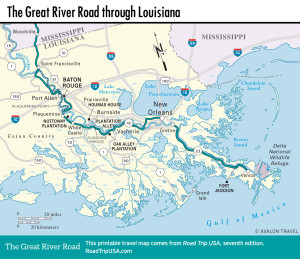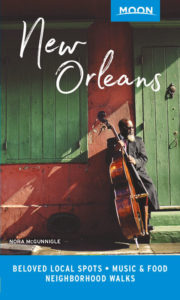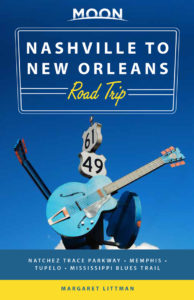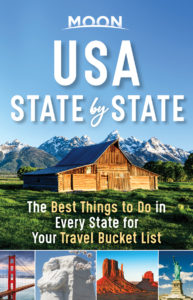New Orleans
Assuming you resisted the industrial-strength charms of US-61 and opted to take the I-10 freeway into town, stay on it until you reach downtown, then get off and park the car as soon as you can, and get out and walk. New Orleans rivals Boston for the discomfort it causes drivers, and there are no driving routes that let you see anything you can’t see better on foot—or from the St. Charles trolley. Parking in and around the French Quarter is a nightmare, and the small print on the signs can set you up for a ticket or a tow, so play it safe and park in one of the many nearby lots, which typically charge anything from $7 to $21 a day (if you can get an early bird rate) to up $12 an hour (if you can’t).
Visiting New Orleans
New Orleans has long been famous for its easygoing, live-and-let-live personality, and for placing a high value on the good things in life—food, drink, and music, to name a few.
With deep roots going back to the earliest days of European settlement in North America, New Orleans is very proud of its multicultural heritage: Its people, its ornate buildings, and especially its food all reflect a uniquely diverse and resilient culture. The focus of New Orleans, for visitors and locals alike, is the Vieux Carré, in the French Quarter, which sits on the highest ground in the city and thus escaped the worst of Katrina’s floods. Centering on Bourbon Street, lined with tacky souvenir stalls and strip clubs catering to conventioneers, this square mile is full of wrought-iron balconies on picturesque brick buildings.
Yes, it’s a huge tourist attraction, but it’s also the heart of old New Orleans. At the center of the quarter is Jackson Square, where a statue of the victor of the Battle of New Orleans, Andrew Jackson, stands in front of St. Louis Cathedral, which was rebuilt in 1850 on top of an original foundation dating back to 1724. The nearby Old U.S. Mint, now the New Orleans Jazz Museum (400 Esplanade, 504/568-6968, closed Mon., $5), holds excellent collections tracing the history of two New Orleans institutions: jazz and Mardi Gras.
After dark, there’s live music aplenty in all styles and modes, but one stop you have to make is Preservation Hall (726 St. Peter St., 504/522-2841, nightly 5, 6, 8, 9, and 10pm, $20), for the redolent ambience and the live traditional Dixieland jazz, still going strong after 50 years.
Where to Eat and Stay in New Orleans
New Orleans has some of the best and most enjoyable places to eat in the world, so plan to take the time to enjoy yourself here. In the French Quarter, the informal Acme Oyster House (724 Iberville St., 504/522-5973) is the place to go for the freshest bivalves, but it closes early by New Orleans standards—around 10pm on weeknights and 11pm on Friday and Saturday.
Another world-famous place that merits a meal or two is NOLA (534 St. Louis St., 504/522-6652), a comparatively casual setting for celebrated chef Emeril Lagasse’s finely crafted Creole fare.
For a taste of local character and Cajun comfort food, ride the St. Charles street car west to friendly Jacques-Imo’s Café (8324 Oak St., 504/861-0886).
No visit to New Orleans is complete without a stop for coffee and beignets (and some serious people-watching) at busy Café du Monde (800 Decatur St., 504/525-4544), open 24 hours (except on Christmas) on the river side of Jackson Square.
Except during Mardi Gras, Jazz Fest, or Superdome football games, places to stay in New Orleans aren’t all that expensive. In the French Quarter, the characterful Olivier House (828 Toulouse St., 504/525-8456, $139 and up) is a quirky, family-run hotel filling a pair of French Quarter townhouses. In the Marigny neighborhood, the historic Hotel Peter & Paul (2317 Burgundy St., 504/356-5200, $119 and up) has a range of comfortable rooms in a restored church and rectory.
Hwy‑23: To the Gulf
From downtown New Orleans, if you really, really want to follow the Mississippi River all the way to its mouth at the Gulf of Mexico, you can. (Well, almost.) From the Superdome, take the US-90 bridge south across the river to Gretna, where you can join the Belle Chasse Highway (Hwy-23), which follows alongside the river for about 75 mi (121 km), ending up at Venice, still 12 mi (19.3 km) from the gulf, on the fringes of the Delta National Wildlife Refuge. Apart from swamps and giant freighters, the main sight along the route is old Fort Jackson, (8 mi (12.9 km) northeast of Venice. Built following the War of 1812 to help protect the river from invasion, Fort Jackson was flooded and badly damaged by the Hurricane Katrina storm surge.
Travel Map of the Great River Road through Louisiana

















